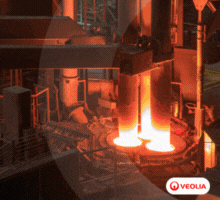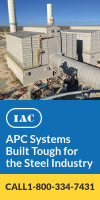60 European Steel Executives: Climate Change Legislation Must Not Jeopardize Industry
10/07/2014 - On 23 and 24 October 2014, the European Union’s heads of state and governments will decide on a new, ambitious long-term energy and climate policy for Europe. In doing so, they will also be making a decision on whether industrial growth and jobs have a place in the future EU economy.
In an open letter published on 6 October, 60 CEOs representing almost 100% of EU steel production said: “We all share the ambition to find an effective response to climate change. To be effective, such a response needs a policy which supports a healthy industry with jobs in Europe.”
The draft European climate and energy policy framework for 2030, in its current form, would put 335,000 direct and 1.5 million indirect steel industry jobs under serious threat, if no clear guidance for safeguarding the competitiveness of industries exposed to global competition is set. This is because the burden on the steel industry, imposed by the policy in its current form, will result in huge losses for even the most efficient steel plants in Europe making them uncompetitive. Once implemented, the EU emissions trading system alone could cost the EU steel industry around €70–100bn in the period 2020 to 2030. These costs are likely to exceed the steel industry’s Ebitda, removing profit margins and the ability to invest.
A healthy foundation industry benefits European society as a whole. The steel industry’s products and product applications and employees, are the foundations for a low carbon, energy efficient, and prosperous European society.
The CEOs’ letter concludes by reminding heads of state of their promise made at the EU summit in March 2014 that the decision on the new policy framework will provide the necessary basis for growth.
“We, the undersigned CEOs, now trust in this promise.”
What the steel industry is asking Europe’s heads of state when they meet on 23 and 24 October, is to adjust the current draft policy framework so that European steel companies can stay competitive on a global level: it is vital to have realistic, sector-based targets that are set according to what is technically and economically possible — as opposed to theoretical targets that are impossible to achieve.
“What we require from the EU summit on 23 and 24 October 2014 is simple: to give clear guidance that the EU’s new climate and energy framework will — at the level of best performers — not impose regulatory direct and indirect CO2 costs on globally competing European industries.”
The draft European climate and energy policy framework for 2030, in its current form, would put 335,000 direct and 1.5 million indirect steel industry jobs under serious threat, if no clear guidance for safeguarding the competitiveness of industries exposed to global competition is set. This is because the burden on the steel industry, imposed by the policy in its current form, will result in huge losses for even the most efficient steel plants in Europe making them uncompetitive. Once implemented, the EU emissions trading system alone could cost the EU steel industry around €70–100bn in the period 2020 to 2030. These costs are likely to exceed the steel industry’s Ebitda, removing profit margins and the ability to invest.
A healthy foundation industry benefits European society as a whole. The steel industry’s products and product applications and employees, are the foundations for a low carbon, energy efficient, and prosperous European society.
The CEOs’ letter concludes by reminding heads of state of their promise made at the EU summit in March 2014 that the decision on the new policy framework will provide the necessary basis for growth.
“We, the undersigned CEOs, now trust in this promise.”
What the steel industry is asking Europe’s heads of state when they meet on 23 and 24 October, is to adjust the current draft policy framework so that European steel companies can stay competitive on a global level: it is vital to have realistic, sector-based targets that are set according to what is technically and economically possible — as opposed to theoretical targets that are impossible to achieve.
“What we require from the EU summit on 23 and 24 October 2014 is simple: to give clear guidance that the EU’s new climate and energy framework will — at the level of best performers — not impose regulatory direct and indirect CO2 costs on globally competing European industries.”



.jpg?lang=en-US&ext=.jpg)
-(1).gif?width=220&height=200&mediaprotectionhash=8011a71ede637cd523c67b1296fc49e6151560fde821a46f29cc85998cc76615&ext=.gif)



